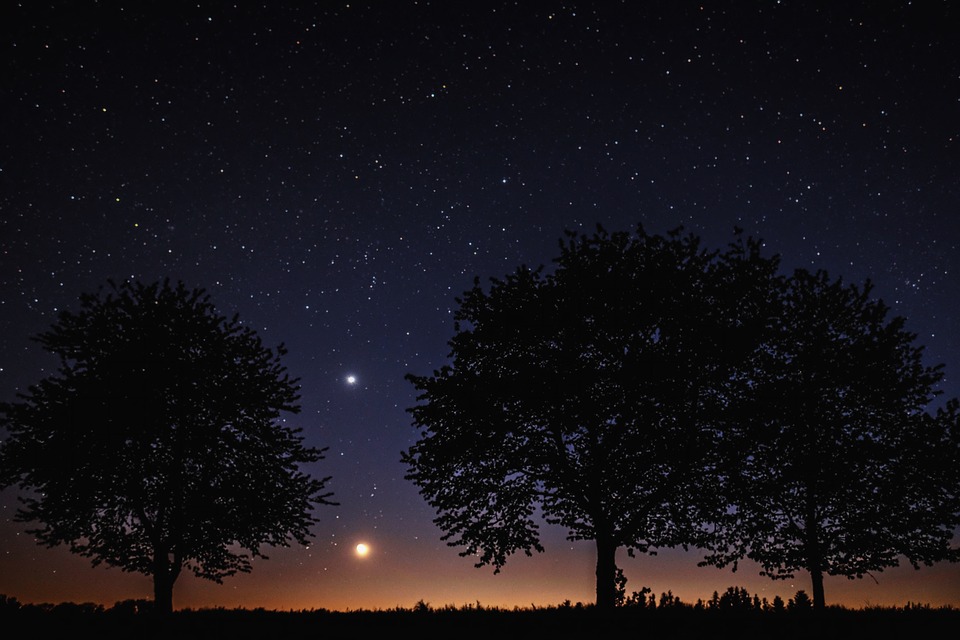Title: Venus in the Evening Sky: How Our Neighboring Planet Illuminates the Night
Introduction
Among the tapestry of celestial objects that dot our evening sky, one planet stands out in its brilliance – Venus. Known as the Morning Star or the Evening Star, this luminous orb shines brightly and often captivates stargazers. But why is Venus so bright, and how does it illuminate our night sky? Let’s delve into the mysteries of our neighboring planet.
The Brightness of Venus
Venus, the second planet from the Sun, is often one of the brightest objects in the sky, outshining all other planets. This feat of brilliance can be attributed to several factors. Firstly, its proximity to Earth is unmatched, making it one of the closest celestial objects we can observe.
Secondly, Venus is covered in a thick layer of highly reflective clouds consisting mainly of sulfuric acid. These clouds bounce off sunlight in all directions, a phenomenon called surface scattering, which amplifies the planet’s brightness as seen from Earth.
Venus’ Ground Pattern, Phases & Orbit
The way Venus moves across our sky has been the subject of fascination for thousands of years. The planet orbits the sun in about 225 Earth days and shows different phases, much like the Moon, depending on how much of its bright side is visible from our vantage point on Earth.
At certain times in its orbit, Venus can appear as a mere crescent in our telescopes, while at other times it appears nearly full or gibbous. The most magnificent sight, however, is Venus when it’s directly opposite the sun, revealing its full disk. This event is called “greatest brilliancy” or “greatest illuminated area” and is an awe-inspiring event for skygazers around the world.
Venus and Its Influences on Ancient Civilizations
Venus has long been a source of fascination and intrigue for human civilizations throughout history. In ancient Egypt and Babylon, the appearances and disappearances of Venus were meticulously tracked and served as the basis for their calendars.
The Sumerian goddess Innana was associated with Venus and represented love, beauty, and war. In Greek and Roman mythology, Venus was linked with the goddesses Aphrodite and Venus, both symbolizing love, beauty, and fertility.
The planet’s regular appearances as both the Morning Star and the Evening Star impressed our ancestors, who often interpreted these celestial patterns as divine messages or omens. Its illumination of the night sky continues to inspire awe in modern society, proving that Venus truly is a celestial neighbor worth getting to know better.
Conclusion
As we peer into the night sky, Venus reminds us of the wonders that lie beyond our planet. The combination of its proximity, reflective clouds, and orbital patterns all contribute to its status as a brilliant and consistent presence in our evening sky. Its influence on ancient civilizations and the mythology surrounding our “Evening Star” only enhances its fascinating story. As you gaze upon Venus the next time it graces the evening sky, take a moment to remember the role it has played in human history and the mysteries it still holds.
Image:
[A vivid image depicting Venus in the evening sky, with the luminous planet shining brightly against a backdrop of stars and a partially obscured moon. The image showcases the beautiful glow of the Celestial Queen.]
FAQs
Q: Can Venus be seen during the day?
A: Yes, due to its extreme brightness, it is sometimes visible during daylight hours just before sunrise or shortly after sunset.
Q: How bright is Venus when compared to other objects in the sky?
A: Venus is usually the third-brightest object in the night sky, after the Moon and the Sun. Among celestial bodies, it can appear as bright as -4.14 magnitude, which is over 60,000 times brighter than the faintest stars visible to the naked eye.
Q: When is the best time of year to observe Venus?
A: Venus becomes particularly visible shortly after sunset or just before sunrise. Its appearances in both morning and evening skies depend on its position in its orbit relative to Earth.
Q: Can I use a telescope to view Venus?
A: Absolutely! Observing Venus through a telescope offers a captivating experience. During times of greatest brilliance or when showing its crescent phase, you can view distinctive cloud bands, notice color changes, and even witness its phases like those of the Moon.
Sources:
1. “The Sky and Telescopes,” edited by Alan Heath
2. “Celestial Handbook,” by Diana and Alexander, Richard A.
3. National Aeronautics and Space Administration (NASA)
4. European Space Agency (ESA)
5. Royal Astronomical Society

